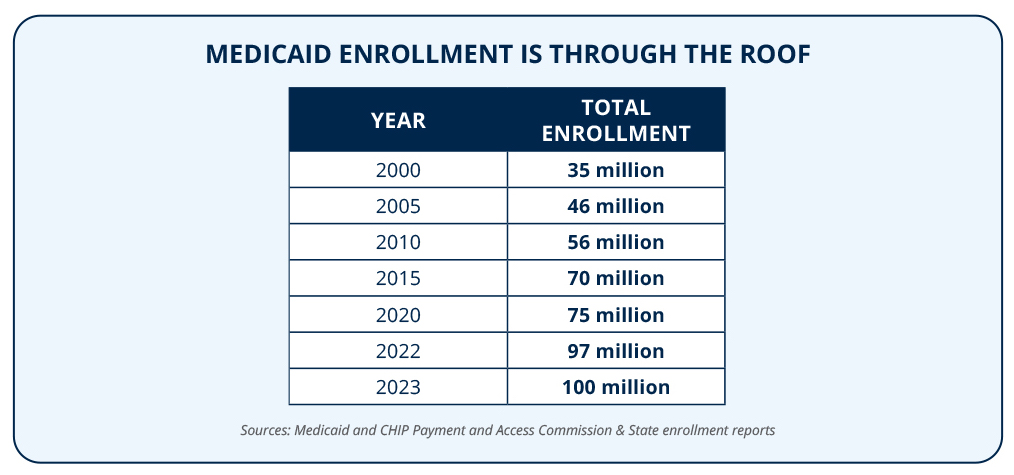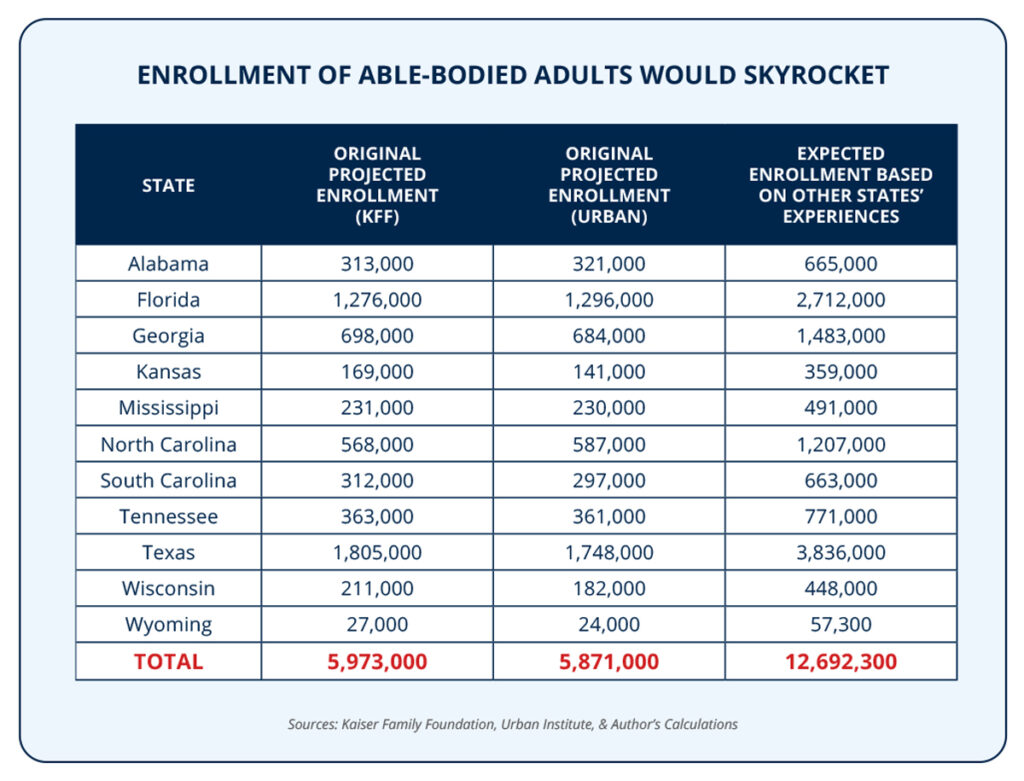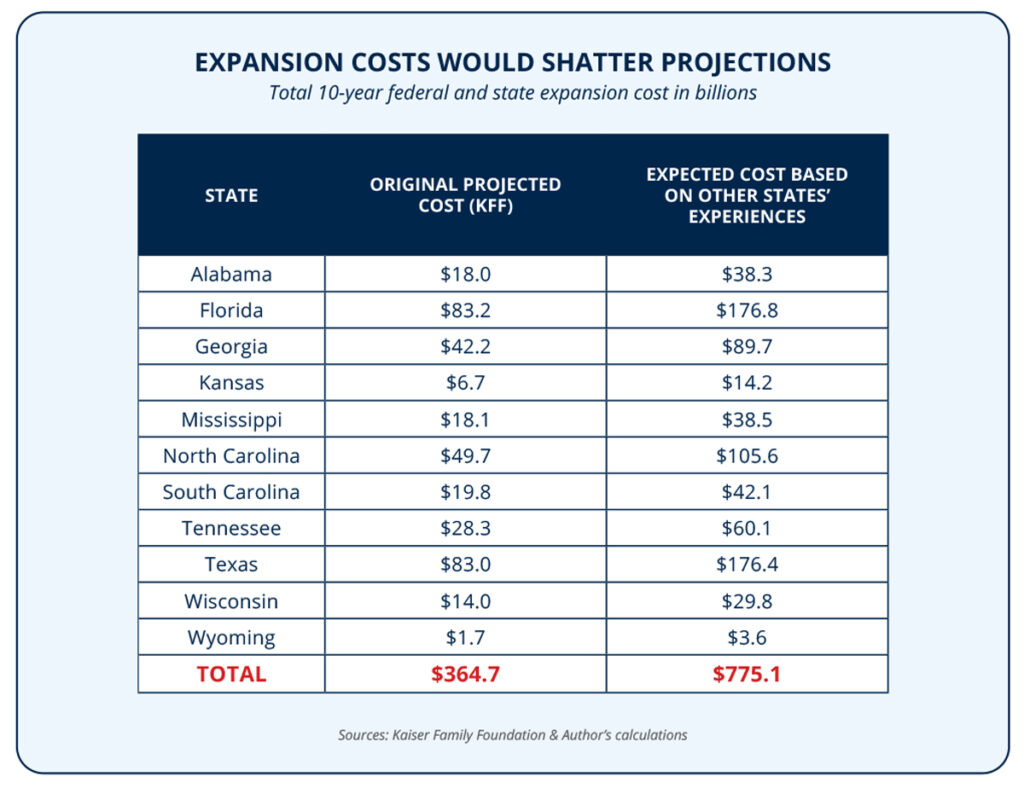Busted Budgets and Skyrocketing Enrollment: Why States Should Reject the False Promises of Medicaid Expansion
KEY FINDINGS
- The Medicaid program was intended to be a safety net for truly needy Americans.
- Total Medicaid enrollment now sits at an all-time high, surpassing 100 million enrollees.
- Non-expansion states could see an enrollment spike by nearly 13 million if they expanded Medicaid.
- If non-expansion states expanded Medicaid, taxpayers could be on the hook for nearly $800 billion.
Overview
The Medicaid program is reeling. The program was designed to provide a safety net for truly needy Americans, such as seniors, individuals with disabilities, and low-income children.1 But the Medicaid program has strayed from its original purpose, loosening eligibility standards throughout the years.2 ObamaCare expansion opened the door to covering able-bodied adults on Medicaid.3
Enrollment has exploded in states that have expanded Medicaid, despite promises from expansion advocates.4Making matters worse, the skyrocketing enrollment of able-bodied adults has come at the expense of the truly needy—those the program was designed to serve.5

As a result, total Medicaid enrollment now sits at an all-time high, surpassing 100 million enrollees in early 2023.6 A program designed to protect those in true need now covers nearly one in three Americans.7
The experience of expansion states throughout the country should serve as a stark warning to non-expansion states. Lawmakers should heed these warnings and reject the broken promises of Medicaid expansion.
Medicaid enrollment is at an all-time high
Enrollment continues to soar as more states expand Medicaid through ObamaCare.8 Today, total Medicaid enrollment is at an all-time high of 100 million with no signs of slowing down, as enrollment is now 35 percent higher than just three years ago—an increase of more than 26 million.9-10

A primary driver of this enrollment explosion is the expansion of Medicaid through ObamaCare, which expands benefits to a new class of able-bodied adults.11 Expansion advocates have long claimed that enrollment would be controlled, but using bad data and worse assumptions have led to misleading and incorrect estimates.12
Indeed, initial projections in expansion states estimated that only 6.5 million able-bodied adults would ever be enrolled after implementing Medicaid expansion.13 The Kaiser Family Foundation (KFF) offered only a slightly higher estimate of 8.6 million able-bodied adults in expansion states.14 But expansion advocates’ estimates have drastically underestimated actual enrollment, which is nearly 19 million—186 percent higher than state estimates and 113 percent higher than KFF’s projections.15-16

While the situation is dire, things can only get worse if the remaining non-expansion states choose to expand Medicaid.
Non-expansion states could see enrollment spike by millions of able-bodied adults
While expansion states nationwide are dealing with Medicaid mayhem, the remaining states are continuing to stand strong against ObamaCare expansion.
According to KFF estimates, the remaining non-expansion states could expect to enroll at least six million able-bodied adults if they opt into expanding Medicaid.17 But the stark reality for these states is that these projections are wildly inaccurate.
Based on the real-world experiences of expansion states, non-expansion states can expect actual enrollment of able-bodied adults to be much higher. In fact, non-expansion states could face enrollment of nearly 13 million able-bodied adults if they expand Medicaid.18

By expanding Medicaid, these states would face the same predicament as others around the country—surging enrollment. Unfortunately, it does not stop there. These enrollment overruns have led to skyrocketing costs, leaving taxpayers with the bill.19
Medicaid expansion costs are soaring—and can only get worse
The same expansion advocates that produced inaccurate enrollment projections also provided cost estimates far below the actual expansion costs.
In 2012, prior to the implementation of Medicaid expansion under ObamaCare, the Department of Health and Human Services (HHS) predicted that expansion would cost $3,200 per person from the outset, growing to nearly $4,000 per person by 2018.20
Unsurprisingly, taxpayers have been on the hook for far more than what these initial projections predicted. Medicaid expansion came with a price tag of more than $5,000 per person in 2014.21 By 2018, annual expansion costs had catapulted to nearly $6,100 per person.22 During expansion’s first five years, taxpayers spent roughly 64 percent more per person than initial HHS predictions.23 And since 2018, these costs have only continued to grow.24
Expansion advocates have been producing inaccurate enrollment and cost estimates from the beginning, so it comes as no surprise that Medicaid expansion has cost more than double what was promised.25 And based on the error rate of expansion advocates and the actual experiences of expansion states, non-expansion states could face nearly $800 billion in costs over the next decade alone if they were to expand Medicaid.26

THE BOTTOM LINE: Lawmakers in non-expansion states must stand firm against the broken promises of Medicaid expansion.
While the debate over Medicaid expansion rages in the remaining non-expansion states, lawmakers need not look any further than the real-life experiences of their counterparts for answers: shattered enrollment projections, massive cost overruns, and the prioritization of able- bodied adults over the truly needy.
Non-expansion states must stand firm against the broken promises of Medicaid expansion to protect the state budget, taxpayers, and the truly needy.
REFERENCES
1 Jonathan Bain and Sam Adolphsen, “Maximize enrollment, weaken program integrity: How the Biden administration’s proposed Medicaid rule would decimate an already broken program,” Foundation for Government Accountability (2022), https://thefga.org/research/maximize-enrollment-weaken-program-integrity.
2 Hayden Dublois and Jonathan Ingram, “An unsustainable path: How ObamaCare’s Medicaid expansion is causing an enrollment and budget crisis,” Foundation for Government Accountability (2022), https://thefga.org/research/how-obamacares-medicaid-expansion-is-causing-crisis.
3 Ibid.
4 Ibid.
5 Jonathan Bain and Sam Adolphsen, “Maximize enrollment, weaken program integrity: How the Biden administration’s proposed Medicaid rule would decimate an already broken program,” Foundation for Government Accountability (2022), https://thefga.org/research/maximize-enrollment-weaken-program-integrity.
6 Ibid.
7 Michael Greibrok, “How Congress and states can rein in Biden bureaucrats while protecting taxpayers’ money and Medicaid program integrity,” Foundation for Government Accountability (2023), https://thefga.org/research/how.congress-states-can-rein-biden-bureaucrats.
8 Hayden Dublois and Jonathan Ingram, “An unsustainable path: How ObamaCare’s Medicaid expansion is causing an enrollment and budget crisis,” Foundation for Government Accountability (2022), https://thefga.org/research/how-obamacares-medicaid-expansion-is-causing-crisis.
9 Author’s calculations based on available nationwide and state-level Medicaid enrollment data.
10 Author’s calculations based on the percentage increase in Medicaid enrollment from February 2020, which was 74 million, to February 2023, which was 100 million.
11 Jonathan Ingram and Sam Adolphsen, “Stopping the Medicaid madness: How Congress and states can start salvaging some program integrity,” Foundation for Government Accountability (2022), https://thefga.org/research/stopping-the-medicaid-madness-how-congress-and-states-can-start-salvaging-some.program-integrity.
12 Hayden Dublois and Jonathan Ingram, “An unsustainable path: How ObamaCare’s Medicaid expansion is causing an enrollment and budget crisis,” Foundation for Government Accountability (2022), https://thefga.org/research/how-obamacares-medicaid-expansion-is-causing-crisis.
13 Ibid.
14 Kaiser Family Foundation, “The cost and coverage implications of the ACA Medicaid expansion: National and state-by-state analysis,” KFF (2012), https://www.kff.org/health-reform/report/the-cost-and-coverage-implications.of-the/.
15 Author’s calculations based on available state-level expansion enrollment data in selected expansion states.
16 Author’s calculations based on the comparison of available state-level expansion enrollment data in selected expansion states and both state government and Kaiser Family Foundation predictions of total expansion enrollment prior to implementation.
17 Kaiser Family Foundation, “The cost and coverage implications of the ACA Medicaid expansion: National and state-by-state analysis,” KFF (2012), https://www.kff.org/health-reform/report/the-cost-and-coverage-implications.of-the/.
18 Author’s calculations based on expansion enrollment error rates applied to total estimated expansion costs over ten years.
19 Hayden Dublois and Jonathan Ingram, “An unsustainable path: How ObamaCare’s Medicaid expansion is causing an enrollment and budget crisis,” Foundation for Government Accountability (2022), https://thefga.org/research/how-obamacares-medicaid-expansion-is-causing-crisis.
20 Ibid.
21 Ibid.
22 Ibid.
23 Ibid.
24 Ibid.
25 Ibid.
26 Author’s calculations based on expansion enrollment error rates applied to total estimated expansion costs over ten years.
